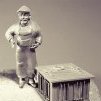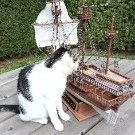Supplies of the Ship Modeler's Handbook are running out. Get your copy NOW before they are gone! Click on photo to order.
×
-
Posts
993 -
Joined
-
Last visited
Reputation Activity
-
 Wintergreen got a reaction from mtaylor in Altair 1931 by KeithAug - FINISHED - Scale 1:32 - schooner
Wintergreen got a reaction from mtaylor in Altair 1931 by KeithAug - FINISHED - Scale 1:32 - schooner
That is a very sharp looking launch. Well done!
-
 Wintergreen got a reaction from KeithAug in Altair 1931 by KeithAug - FINISHED - Scale 1:32 - schooner
Wintergreen got a reaction from KeithAug in Altair 1931 by KeithAug - FINISHED - Scale 1:32 - schooner
That is a very sharp looking launch. Well done!
-
 Wintergreen reacted to matiz in French 74-gun ship by matiz - scale 1:56 - Tiziano Mainardi
Wintergreen reacted to matiz in French 74-gun ship by matiz - scale 1:56 - Tiziano Mainardi
Hi, and tanks
another pictures:
-
 Wintergreen reacted to SJSoane in HMS Bellona 1760 by SJSoane - Scale 1:64 - English 74-gun - as designed
Wintergreen reacted to SJSoane in HMS Bellona 1760 by SJSoane - Scale 1:64 - English 74-gun - as designed
Hi druxey,
Yes, you are right! I wish I had thought of that. Oh, well, when I do my next 25 year long 74 gun ship, I will get the order right!
Mark
-
 Wintergreen got a reaction from kees de mol in Kågen by Wintergreen - FINISHED - 1:30 - Swedish clinker-built cog work boat - SMALL
Wintergreen got a reaction from kees de mol in Kågen by Wintergreen - FINISHED - 1:30 - Swedish clinker-built cog work boat - SMALL
As per requested, the day was spent in the small ship yard ;-)
What did master accomplish?
Some much needed clean up of some rubbish in the corners of the shop.
Assembled the keel, stem and stern.
Managed a decent tapering of the structure.
And also something to be not so overly proud of, though I thing it happens to all of us...
For the assembly I started with the fore knee and glued it to the keel. Then I faired the surface that faced the stem. My template was faired alongside this to get angles of stem and stern fairly close to spec.
The aft part then, sternpost and knee glued together. Some minor adjustments and it was glued to the keel.
Drilling for bolts were done on freehand (which can clearly be seen in pic 1) with my bulky Dremel.
Note to self: Save up for a Proxxon multitool and drilling station.
Tapering of the structure was accomplished with another annealed mat knife blade.
Sometime during the day I recognized that my floor was a mess so I wiped. In hindsight I would have benefited from looking if any of the pieces had gone astray before I wiped the floor.
Find the anomaly...
Note to self 2: Keep small parts contained in something (anything!)
Apart from that minor setback I'm fairly satisfied with the day.
Til next time, ta!
-
 Wintergreen got a reaction from Mike Y in Kågen by Wintergreen - FINISHED - 1:30 - Swedish clinker-built cog work boat - SMALL
Wintergreen got a reaction from Mike Y in Kågen by Wintergreen - FINISHED - 1:30 - Swedish clinker-built cog work boat - SMALL
Haha John, no it sits steady on terra firma. At the moment I'm refurbishing the galley. The old owner /builder merely gave the interior one slush of varnish...
-
 Wintergreen got a reaction from Reverend Colonel in Kågen by Wintergreen - FINISHED - 1:30 - Swedish clinker-built cog work boat - SMALL
Wintergreen got a reaction from Reverend Colonel in Kågen by Wintergreen - FINISHED - 1:30 - Swedish clinker-built cog work boat - SMALL
Hi again all,
another update.
The days I don't have to commute to work I save three ours of my life. Today I spent those hours at the yard :-)
Work continued with forming the pieces. First by file in my vice and then at the disc sander. Yes, it's the same lathe that doubles (or triples) as thickness sander also, except being a lathe...
Vaddoc, I now know what you mean with the glue. It took a thorough wipe with methylated spirits to get the glue off. The glue can come in handy in other applications perhaps.
When all parts were ready, the rabbet was next. I've seen from other logs how the builder has shaped a mat knife blade or similar to scrape mouldings and stuff. The rabbet here is quite straight forward, just some different angles, that's it.
As a first attempt the blade was squeezed in one of my clamps. If examined closely it can be seen that the rabbet takes a shortcut over the most acute bend on the stern. It was due to the clamps being too clumsy. Also, the tip of the blade broke off leaving an uneven rabbet as well.
(funny, what are my shoes doing in that picture...)
Option two. Two mount plates held together with wing nuts. Fairly easy I'd say. To fix the blade the torch came out to anneal it. After sharpening to an angle of ca 30 degrees the torch came to work again. This time the blade was quenched in water to be hardened again.
It is a bit fiddly to set the cut up, but then it is just to scrape away.
Now I appreciated my two sets of boat pieces because I fiddled a bit too much with the blade on the first set and had to go over the rabbets a second time.
With the other set I will be meticulous in setting the blade and then do all the rabbets at once.
For the weekend I might take a trip to my real boat or I might choose to stay at home in the yard. What do you reckon?
-
 Wintergreen reacted to Pirate adam in Washington 1777 by Pirate adam - 1:48 scale - Galley - POF
Wintergreen reacted to Pirate adam in Washington 1777 by Pirate adam - 1:48 scale - Galley - POF
The tricky ones....
-
 Wintergreen reacted to SJSoane in HMS Bellona 1760 by SJSoane - Scale 1:64 - English 74-gun - as designed
Wintergreen reacted to SJSoane in HMS Bellona 1760 by SJSoane - Scale 1:64 - English 74-gun - as designed
Thank you, Marc, for your words of encouragement, and I enjoyed your tag line of "we are all works in progress, all of the time." Applies to us and our models.
Once I rounded the bows and began placing planks further aft, I realized that the wale dips below the lower gundeck at midships; and therefore, my clamps from above would no longer work. So I rummaged through my box of old tools, and recovered the clamps I had made almost 20 years ago to clamp up the growing sandwich of frames in the admiralty framing system.
I ran these through the open frames athwartships, and they worked perfectly to clamp from below. I just have to be very careful not to nick the frames when I pass the threaded rod through. I wrapped them in tape to help avoid the worst damage.
Mark
-
 Wintergreen reacted to EdT in Young America 1853 by EdT - FINISHED - extreme clipper
Wintergreen reacted to EdT in Young America 1853 by EdT - FINISHED - extreme clipper
Young America - extreme clipper 1853
Part 262 – Fore Lower Topsail Yard Truss
When a double topsail (or double topgallant sail) arrangement was adopted, the lower yard position on the mast was fixed, and therefore this sail was not reefed. Any reduction in overall topsail area was done by taking in the upper topsail. Under the Howe patent, the arrangement most likely followed when Young America adopted double topsails in 1854, the lower yard was supported from the forward end of the lower mast cap by means of an iron truss that allowed the yard to rotate in two planes like the lower fore yard below.
The first picture shows the installed sling band with a double bracket that will fit over a shaft on the truss itself.
The band is pinned through the yard and the underside drilled for the sheet block eyebolt. The band is octagonal, made from .010" (about ¾" at 1:72) copper sheet. The band was soldered first. A U-shaped bracket was then formed from .015" copper, and drilled to accept the truss shaft. Both parts are shown in the next picture.
The u-shape was used to assure that the bracket holes would line up after assembly. The joining top piece will be removed later. The next picture shows the two pieces being set up for soldering.
After soldering, the assembly was set up in the vise as shown below to file off the end of the U and shape the brackets as shown in the last photo below.
The U was formed over a wood block that was kept in place when the bracket holes were drilled. In the above picture a small piece of this block is inserted to allow the bracket to be clamped for filling.
The truss itself is shown in the next few pictures. To start, two pieces of telescoping tube were soldered together then soldered to the top of a copper block that will be shaped to the truss configuration. Using tube avoids drilling aligned holes and assured a match with the hole in the mast cap boss. This initial assembly is being marked in the first picture.
The truss was then cut and filed to its overall shape shown in the next picture where it has been temporarily mounted to check fit.
In the next picture the truss shaft is being filed round..
In the picture the 5" shaft is being rounded from a sized square, to an octagon to a round – as was done in making the spars. In the last picture, the full truss assembly is temporarily mounted with the yard.
The forward end of the truss shaft will be fitted with a retaining cap and cut off. This will be done later after the other yard ironwork is fitted. All will then be blackened and the yard given some finish as was done before.
You may note in this picture that the ratline work on the topmast is still in progress.
Ed
-
 Wintergreen reacted to KeithAug in Altair 1931 by KeithAug - FINISHED - Scale 1:32 - schooner
Wintergreen reacted to KeithAug in Altair 1931 by KeithAug - FINISHED - Scale 1:32 - schooner
I finished the launch by attaching the wheel and throttle lever.
-
 Wintergreen got a reaction from Elijah in Help decide next project for Syren Ship Model Company
Wintergreen got a reaction from Elijah in Help decide next project for Syren Ship Model Company
I will lay my vote for the Chewbacca.. sorry the Chebacco.
Mostly because, as some stated, there are numerous kits of those with cannons.
Then I'm not overly fond of the Dutch lines, they don't appeal to me (Note, very personal opinon!)
Therefore the other work boat. Nice lines, fair amount of detail, manageable size.
But that's only my to cents.
-
 Wintergreen got a reaction from KeithAug in Kågen by Wintergreen - FINISHED - 1:30 - Swedish clinker-built cog work boat - SMALL
Wintergreen got a reaction from KeithAug in Kågen by Wintergreen - FINISHED - 1:30 - Swedish clinker-built cog work boat - SMALL
As per requested, the day was spent in the small ship yard ;-)
What did master accomplish?
Some much needed clean up of some rubbish in the corners of the shop.
Assembled the keel, stem and stern.
Managed a decent tapering of the structure.
And also something to be not so overly proud of, though I thing it happens to all of us...
For the assembly I started with the fore knee and glued it to the keel. Then I faired the surface that faced the stem. My template was faired alongside this to get angles of stem and stern fairly close to spec.
The aft part then, sternpost and knee glued together. Some minor adjustments and it was glued to the keel.
Drilling for bolts were done on freehand (which can clearly be seen in pic 1) with my bulky Dremel.
Note to self: Save up for a Proxxon multitool and drilling station.
Tapering of the structure was accomplished with another annealed mat knife blade.
Sometime during the day I recognized that my floor was a mess so I wiped. In hindsight I would have benefited from looking if any of the pieces had gone astray before I wiped the floor.
Find the anomaly...
Note to self 2: Keep small parts contained in something (anything!)
Apart from that minor setback I'm fairly satisfied with the day.
Til next time, ta!
-
 Wintergreen got a reaction from Baker in Kågen by Wintergreen - FINISHED - 1:30 - Swedish clinker-built cog work boat - SMALL
Wintergreen got a reaction from Baker in Kågen by Wintergreen - FINISHED - 1:30 - Swedish clinker-built cog work boat - SMALL
As per requested, the day was spent in the small ship yard ;-)
What did master accomplish?
Some much needed clean up of some rubbish in the corners of the shop.
Assembled the keel, stem and stern.
Managed a decent tapering of the structure.
And also something to be not so overly proud of, though I thing it happens to all of us...
For the assembly I started with the fore knee and glued it to the keel. Then I faired the surface that faced the stem. My template was faired alongside this to get angles of stem and stern fairly close to spec.
The aft part then, sternpost and knee glued together. Some minor adjustments and it was glued to the keel.
Drilling for bolts were done on freehand (which can clearly be seen in pic 1) with my bulky Dremel.
Note to self: Save up for a Proxxon multitool and drilling station.
Tapering of the structure was accomplished with another annealed mat knife blade.
Sometime during the day I recognized that my floor was a mess so I wiped. In hindsight I would have benefited from looking if any of the pieces had gone astray before I wiped the floor.
Find the anomaly...
Note to self 2: Keep small parts contained in something (anything!)
Apart from that minor setback I'm fairly satisfied with the day.
Til next time, ta!
-
 Wintergreen got a reaction from popeye the sailor in Kågen by Wintergreen - FINISHED - 1:30 - Swedish clinker-built cog work boat - SMALL
Wintergreen got a reaction from popeye the sailor in Kågen by Wintergreen - FINISHED - 1:30 - Swedish clinker-built cog work boat - SMALL
Vaddoc, thanks for the comment.
I plan to compare the sapwood of apple to birch. I've read that birch is a good wood for planking models. Will do tests later of steaming and bending, as well as to see how they keep their edges sharp (basically wood density).
Stay tuned.
-
 Wintergreen got a reaction from popeye the sailor in Kågen by Wintergreen - FINISHED - 1:30 - Swedish clinker-built cog work boat - SMALL
Wintergreen got a reaction from popeye the sailor in Kågen by Wintergreen - FINISHED - 1:30 - Swedish clinker-built cog work boat - SMALL
Denis, I hear what you are saying...
-
 Wintergreen got a reaction from mtaylor in Kågen by Wintergreen - FINISHED - 1:30 - Swedish clinker-built cog work boat - SMALL
Wintergreen got a reaction from mtaylor in Kågen by Wintergreen - FINISHED - 1:30 - Swedish clinker-built cog work boat - SMALL
Haha John, no it sits steady on terra firma. At the moment I'm refurbishing the galley. The old owner /builder merely gave the interior one slush of varnish...
-
 Wintergreen got a reaction from Andrea Rossato in Kågen by Wintergreen - FINISHED - 1:30 - Swedish clinker-built cog work boat - SMALL
Wintergreen got a reaction from Andrea Rossato in Kågen by Wintergreen - FINISHED - 1:30 - Swedish clinker-built cog work boat - SMALL
Hi again all,
another update.
The days I don't have to commute to work I save three ours of my life. Today I spent those hours at the yard :-)
Work continued with forming the pieces. First by file in my vice and then at the disc sander. Yes, it's the same lathe that doubles (or triples) as thickness sander also, except being a lathe...
Vaddoc, I now know what you mean with the glue. It took a thorough wipe with methylated spirits to get the glue off. The glue can come in handy in other applications perhaps.
When all parts were ready, the rabbet was next. I've seen from other logs how the builder has shaped a mat knife blade or similar to scrape mouldings and stuff. The rabbet here is quite straight forward, just some different angles, that's it.
As a first attempt the blade was squeezed in one of my clamps. If examined closely it can be seen that the rabbet takes a shortcut over the most acute bend on the stern. It was due to the clamps being too clumsy. Also, the tip of the blade broke off leaving an uneven rabbet as well.
(funny, what are my shoes doing in that picture...)
Option two. Two mount plates held together with wing nuts. Fairly easy I'd say. To fix the blade the torch came out to anneal it. After sharpening to an angle of ca 30 degrees the torch came to work again. This time the blade was quenched in water to be hardened again.
It is a bit fiddly to set the cut up, but then it is just to scrape away.
Now I appreciated my two sets of boat pieces because I fiddled a bit too much with the blade on the first set and had to go over the rabbets a second time.
With the other set I will be meticulous in setting the blade and then do all the rabbets at once.
For the weekend I might take a trip to my real boat or I might choose to stay at home in the yard. What do you reckon?
-
 Wintergreen got a reaction from kees de mol in Kågen by Wintergreen - FINISHED - 1:30 - Swedish clinker-built cog work boat - SMALL
Wintergreen got a reaction from kees de mol in Kågen by Wintergreen - FINISHED - 1:30 - Swedish clinker-built cog work boat - SMALL
Thanks for the comments and likes :-)
Denis, glad you remember the Regina project. She sits nicely in her display case. And re the drum, there was never an issue with the drum going into an orbit. It was held in place by the dubbs (? maybe they are called something else ?). But a coned shaft is of course a better option.
Vaddoc, the apple is two colored. Outer wood is much paler. I will take a picture to show you. Also, thanks for the heads up on the glue. Guess now that I've bought that expensive bottle I need to use it... And the boat (or type) does not have a centerboard. I cant think of any traditional Swedish boat that has that. Instead lead or iron ingots as ballast. Approx 500 kg for this 22 footer.
Edit:
Picture of the apple wood.
-
 Wintergreen got a reaction from MEDDO in Help decide next project for Syren Ship Model Company
Wintergreen got a reaction from MEDDO in Help decide next project for Syren Ship Model Company
I will lay my vote for the Chewbacca.. sorry the Chebacco.
Mostly because, as some stated, there are numerous kits of those with cannons.
Then I'm not overly fond of the Dutch lines, they don't appeal to me (Note, very personal opinon!)
Therefore the other work boat. Nice lines, fair amount of detail, manageable size.
But that's only my to cents.
-
 Wintergreen got a reaction from kees de mol in Kågen by Wintergreen - FINISHED - 1:30 - Swedish clinker-built cog work boat - SMALL
Wintergreen got a reaction from kees de mol in Kågen by Wintergreen - FINISHED - 1:30 - Swedish clinker-built cog work boat - SMALL
Hi again all,
another update.
The days I don't have to commute to work I save three ours of my life. Today I spent those hours at the yard :-)
Work continued with forming the pieces. First by file in my vice and then at the disc sander. Yes, it's the same lathe that doubles (or triples) as thickness sander also, except being a lathe...
Vaddoc, I now know what you mean with the glue. It took a thorough wipe with methylated spirits to get the glue off. The glue can come in handy in other applications perhaps.
When all parts were ready, the rabbet was next. I've seen from other logs how the builder has shaped a mat knife blade or similar to scrape mouldings and stuff. The rabbet here is quite straight forward, just some different angles, that's it.
As a first attempt the blade was squeezed in one of my clamps. If examined closely it can be seen that the rabbet takes a shortcut over the most acute bend on the stern. It was due to the clamps being too clumsy. Also, the tip of the blade broke off leaving an uneven rabbet as well.
(funny, what are my shoes doing in that picture...)
Option two. Two mount plates held together with wing nuts. Fairly easy I'd say. To fix the blade the torch came out to anneal it. After sharpening to an angle of ca 30 degrees the torch came to work again. This time the blade was quenched in water to be hardened again.
It is a bit fiddly to set the cut up, but then it is just to scrape away.
Now I appreciated my two sets of boat pieces because I fiddled a bit too much with the blade on the first set and had to go over the rabbets a second time.
With the other set I will be meticulous in setting the blade and then do all the rabbets at once.
For the weekend I might take a trip to my real boat or I might choose to stay at home in the yard. What do you reckon?
-
 Wintergreen reacted to popeye the sailor in Kågen by Wintergreen - FINISHED - 1:30 - Swedish clinker-built cog work boat - SMALL
Wintergreen reacted to popeye the sailor in Kågen by Wintergreen - FINISHED - 1:30 - Swedish clinker-built cog work boat - SMALL
the rabbits look good.......it was worth all you had to do to get there the extra keel blank is a good thing. as for which to do this week end.....if it's winter and your boat is as far as going to work, it might be nice to close yourself up in a nice warm shop and enjoy life always good to see more updates
-
 Wintergreen got a reaction from popeye the sailor in Kågen by Wintergreen - FINISHED - 1:30 - Swedish clinker-built cog work boat - SMALL
Wintergreen got a reaction from popeye the sailor in Kågen by Wintergreen - FINISHED - 1:30 - Swedish clinker-built cog work boat - SMALL
Haha John, no it sits steady on terra firma. At the moment I'm refurbishing the galley. The old owner /builder merely gave the interior one slush of varnish...
-
 Wintergreen got a reaction from KeithAug in Kågen by Wintergreen - FINISHED - 1:30 - Swedish clinker-built cog work boat - SMALL
Wintergreen got a reaction from KeithAug in Kågen by Wintergreen - FINISHED - 1:30 - Swedish clinker-built cog work boat - SMALL
Hi again all,
another update.
The days I don't have to commute to work I save three ours of my life. Today I spent those hours at the yard :-)
Work continued with forming the pieces. First by file in my vice and then at the disc sander. Yes, it's the same lathe that doubles (or triples) as thickness sander also, except being a lathe...
Vaddoc, I now know what you mean with the glue. It took a thorough wipe with methylated spirits to get the glue off. The glue can come in handy in other applications perhaps.
When all parts were ready, the rabbet was next. I've seen from other logs how the builder has shaped a mat knife blade or similar to scrape mouldings and stuff. The rabbet here is quite straight forward, just some different angles, that's it.
As a first attempt the blade was squeezed in one of my clamps. If examined closely it can be seen that the rabbet takes a shortcut over the most acute bend on the stern. It was due to the clamps being too clumsy. Also, the tip of the blade broke off leaving an uneven rabbet as well.
(funny, what are my shoes doing in that picture...)
Option two. Two mount plates held together with wing nuts. Fairly easy I'd say. To fix the blade the torch came out to anneal it. After sharpening to an angle of ca 30 degrees the torch came to work again. This time the blade was quenched in water to be hardened again.
It is a bit fiddly to set the cut up, but then it is just to scrape away.
Now I appreciated my two sets of boat pieces because I fiddled a bit too much with the blade on the first set and had to go over the rabbets a second time.
With the other set I will be meticulous in setting the blade and then do all the rabbets at once.
For the weekend I might take a trip to my real boat or I might choose to stay at home in the yard. What do you reckon?
-
 Wintergreen got a reaction from John Allen in Kågen by Wintergreen - FINISHED - 1:30 - Swedish clinker-built cog work boat - SMALL
Wintergreen got a reaction from John Allen in Kågen by Wintergreen - FINISHED - 1:30 - Swedish clinker-built cog work boat - SMALL
Hi again all,
another update.
The days I don't have to commute to work I save three ours of my life. Today I spent those hours at the yard :-)
Work continued with forming the pieces. First by file in my vice and then at the disc sander. Yes, it's the same lathe that doubles (or triples) as thickness sander also, except being a lathe...
Vaddoc, I now know what you mean with the glue. It took a thorough wipe with methylated spirits to get the glue off. The glue can come in handy in other applications perhaps.
When all parts were ready, the rabbet was next. I've seen from other logs how the builder has shaped a mat knife blade or similar to scrape mouldings and stuff. The rabbet here is quite straight forward, just some different angles, that's it.
As a first attempt the blade was squeezed in one of my clamps. If examined closely it can be seen that the rabbet takes a shortcut over the most acute bend on the stern. It was due to the clamps being too clumsy. Also, the tip of the blade broke off leaving an uneven rabbet as well.
(funny, what are my shoes doing in that picture...)
Option two. Two mount plates held together with wing nuts. Fairly easy I'd say. To fix the blade the torch came out to anneal it. After sharpening to an angle of ca 30 degrees the torch came to work again. This time the blade was quenched in water to be hardened again.
It is a bit fiddly to set the cut up, but then it is just to scrape away.
Now I appreciated my two sets of boat pieces because I fiddled a bit too much with the blade on the first set and had to go over the rabbets a second time.
With the other set I will be meticulous in setting the blade and then do all the rabbets at once.
For the weekend I might take a trip to my real boat or I might choose to stay at home in the yard. What do you reckon?











